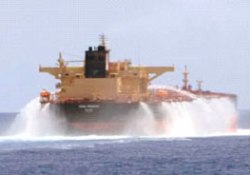
When I saw that a Chinese ship had been hijacked last week, I thought it was about time for a piracy report, as after a large burst of publicity late last year surrounding the Somali pirates, there has been very little follow up in the mainstream media. While piracy is no longer front-page news, it is still alive and well, with the ocean around the world’s no.1 failed state, Somalia, still the global hot zone:
The hijacking of a Chinese coal ship in the Indian Ocean shows Somali pirates are extending their reach beyond the Gulf of Aden and the Somali coast, shippers said as traders worried that more coal ships could become targets. (Reuters report)
Further information up this week shows that although the media may have lost interest, the pirates have not. As confirmed by CNN, “pirate attacks off the coast of east Africa have increased this year, according to the International Maritime Bureau, which monitors shipping crimes. The first nine months of this year has seen more pirate attacks than all of last year.”
The International Chamber of Commerce Commercial Crime Services (ICC-CCS) has become much more active in monitoring incidents of piracy around the world, and it has just released the following information:
Global piracy statistics reveal that in the first nine months of 2009, 114 vessels were boarded, 34 vessels hijacked and 88 vessels fired upon. A total of 661 crewmembers were taken hostage, 12 kidnapped, six killed and eight reported missing.
Jeez Louise, you’d want some pretty hefty danger money to sail through those seas, wouldn’t you?
If you want to investigate further, the ICC-CCS website now features an interactive Live Piracy Map and a Live Piracy Report. Both are constantly updated as soon as attacks are radioed in from shipping around the globe. Half of all attacks take place in the region around Somalia, but the presence of naval vessels from a number of different countries has meant that these pirates have had to adapt somewhat. The pirates now range over a much wider swathe of ocean — from off the coast of Kenya right up to the southern region of the Red Sea.
The other worrying trend is a rise in pirate attacks on the opposite coast of Africa, particularly around Nigeria and Lagos. One suspects that the relative success of Somali pirates in gaining ransom money might serve as incentive to other potential criminals. Despite this, ICC-CCS writes that:
There has been a marked decrease globally, however, in the number of vessels hijacked in the first nine months of 2009, compared to the same period in 2008 – from an average of one in 6.4 vessels in 2008 to one in nine vessels in 2009.
Just to clarify the seemingly contradictory statments above: there has been an increase in attacks, but a decrease in successful hijacks.
This decrease has been brought about by a number of factors — greater vigilance and rapid response by armed naval vessels; new avoidance techniques adopted by cargo ships so as to make it as difficult as possible for pirates to board them (from what I’ve read, the policy is just to open the ship up to full speed and try to outrun the pirates); new non-lethal defensive measures such as the water cannon pictured below. Try climbing up the side of a container vessel under those sorts of waterfalls!

Filed under: Culture, Politics | Tagged: Piracy, Pirates, Somalia |


British yacht couple in Somali pirate lair
Friday, October 30, 2009
A British couple whose Indian Ocean yachting holiday was cut short when their yacht was hijacked have joined hostages on another captured ship at the Somali pirate lair of Harardhere.
Paul Chandler, 58, and his wife Rachel, 55, have not been heard from since last Friday when they set off a distress signal from the Lynn Rival, on its way from the Seychelles to Tanzania.
The British Ministry of Defence confirmed that their abandoned yacht had been sighted.
Pirates continued their rampage around the Seychelles and seized a Thailand-flagged trawler yesterday, bringing to nine the number of hijacked ships held off Somalia.
ADVERTISEMENT
The European Union’s anti-piracy naval force said the Thai Union 3, believed to be crewed by Russians, came under attack from two pirate skiffs.
The developments came as China prepared to deploy a fresh naval convoy to the Gulf of Aden to protect vessels from Somali pirates, just 10 days after a Chinese bulk carrier was hijacked.
The flotilla setting sail today will consist of two missile frigates tasked with replacing two other Chinese frigates patrolling shipping lanes in the gulf.
The capture of the De Xin Hai with 25 crew last week prompted Beijing to vow to rescue the vessel and crew.
迷你倉
[…] Pirate Report […]